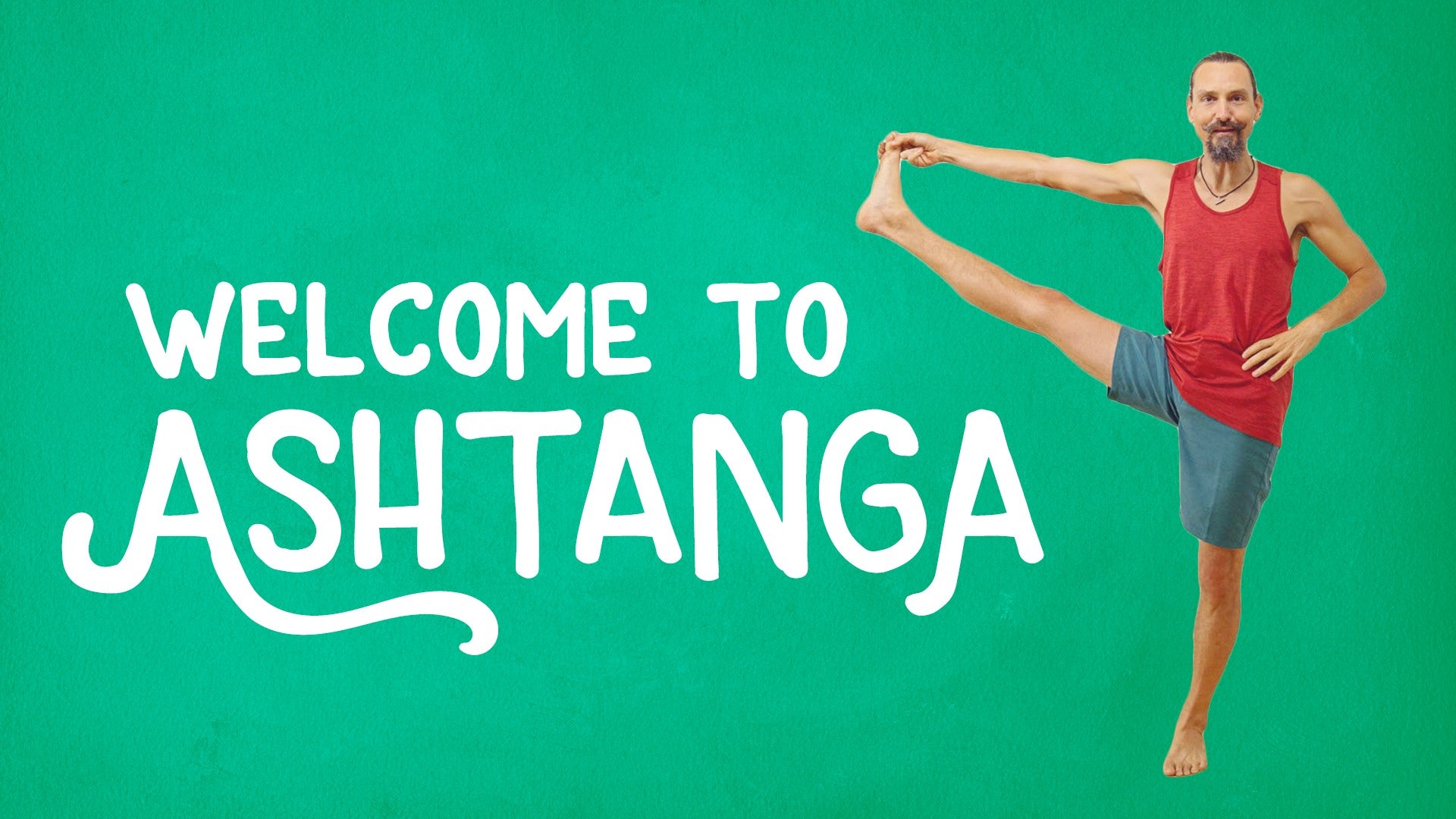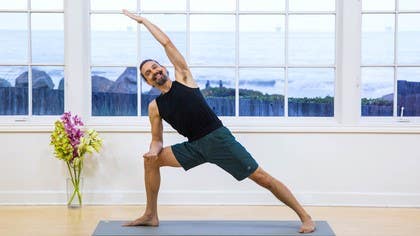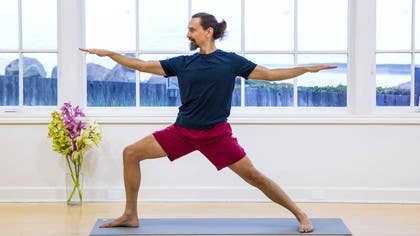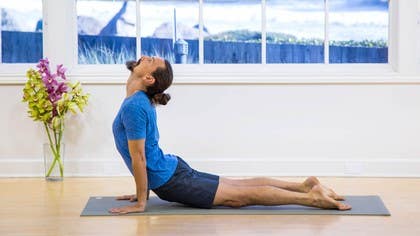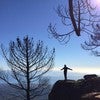Description
About This Video
Transcript
Read Full Transcript
Welcome to a beginner's practice. So a shortened form of the ashtanga practice, just including the fundamental standing asanas, some back bends and some finishing poses, can be a great service. Whether you're working towards a longer, deeper practice, practicing along here at yoga anytime, or whether you're restarting an older practice or whether you just need a more compressed practice for today, we hope that you can really practice along here and get the maximum benefit out of this shorter form. Come join me in samastitihi, top of the mat. We'll do just three sun salutation, eh? Exhale completely. Ekameenhale, rising the arms, straight up, seeing the thumbs meet. Dwe exhale, folding forward. You might need to bend the knees the first one or two times. Trini, inhale, head up, long spine, look forward. And chatwadi, exhale, stepping or jumping, lowering into any chaturanga variation that is of service to you. Punch an inhale, the chest forwards through the shoulders and the upward facing dog. Chat exhale to downward facing dog. Keeping the downward dog nice and long, one. And your breath nice and long, slow, full and deep, two. Every exhalation a great chance to remind yourself of udiyana and mula bandha, three. And the drishti, the eyes settling into a still point, four. Maybe on your nose, your navel or your knee, five. Sapta, inhaling and during the inhalation, stepping or jumping forward, head up, look forward. Ashtau, exhale, folding forward, drop the head, let the hands come down as deep as they can. And nava, inhale, rising up, see the thumbs meeting together. Exhale, back to your neutral posture samastitihi. Ekameenhale, allowing the breath to shape the posture, arms up. Dwe exhale, folding forward, keep the belly rising as the head drops. Trini, inhale, long spine looking forward. And Chaturthi, exhale, planting the hands, stepping or jumping, lowering into any chaturanga. Pancha, inhale, chest forward, the elbows micro bend and upward facing dog. Shat, exhale, downward facing dog, letting the head reside in a comfortable neutral position, one. Two, you may feel the spine in line with the arms, three, as the fingers and toes spread deeply. Four, grounding through the root knuckles, your index mound and your big toe mound pressing down. Five, sapta, inhale, step or jump the feet forward, the head up. Ashtau, exhale, folding forward, letting the hands even ground into the mat, if that's accessible to you. Another inhale, rising up, the tailbone pointing down, the hands reaching up. Exhale, samastitihi. Last one, ekim, inhale, arms up. Two, exhale, fold forward. Trini, inhale, head up. Chaturthi, exhale, step or jump back, chaturanga. Pancha, inhale, upward facing. Shat, exhale, downward facing dog. One, remembering to measure the air at the back of the throat. Two, three, long full deep breathing with sound. Five, sapta, inhale, step or jump forward, feet together, head up. Ashtau, exhale, fold forward, drop the head. Another inhale, rising up, lengthening the tailbone down, lifting the chest up. Exhale, samastitihi. Surinamaskar B, ekim, inhale, bend the knees, let the pelvis sink as the arms lift, see thumbs. Two, exhale, fold forward, drop the head down. Trini, inhale, still grinding through the feet with strong legs, look forward. And Chaturthi, exhale, step or jump to any chaturanga position. Pancha, inhale, upward facing dog. Shat, exhale, downward facing dog. Sapta, inhale, step the right foot forward, your left heel pressing into the mat, arms up, see thumbs. Ashtau, exhale, the hands right back where they were, the right foot back where it was in any chaturanga variation. Nava, inhale, upward facing dog. Dasha, exhale, downward facing dog. Ekadasha, inhale, left foot forward, your heels in one line, see your thumbs meet. Dwadasha, exhale, chaturanga dandasana. Trayog, dasha, inhale, upward facing dog. Chaturg, exhale, downward facing dog. Long, smooth, fully breathing with sound. One, allowing your awareness to go back internally. Two, so that every exhalation can help to empty out the lower abdomen. Three, feel a nice engagement in between the hips. Four, keeping the low belly strong and raising the pelvic floor, mula bandha as well. Five, panjarasha, inhale, step or hop, feet forward together, head up, shurasha, exhale and fold. Saptarasha, inhale, bending the knees, feeling weight through the feet, exhale and stand strong into samastitihi, knee caps lifted, legs strong. Last one, ahekam, inhale, bend the knees, arms up. Dway, exhale, fold forward, drop the head, still following your breath. Trini, inhale, the collarbones broad, the chest floats forward. Chaturadi, exhale, chaturanga. Pancha, inhale, the chest goes forward through the shoulders, rolling back and down, upward dog. Shat, exhale, downward facing dog. Sapta, inhaling, measuring the breath as the right foot forward, arms up, see the thumb. Ashta, exhale, the hands down the right foot back, chaturanga. Nava, inhale, upward facing dog. Dasha, exhale, downward facing dog. Ekadasha, inhale, left foot forward, arms up, see your thumbs. Dwadasha, exhale, chaturanga, dandasana. Trayog, dasha, inhale, upward facing dog. Chaturg, dasha, exhale, downward facing dog. Any variation of any posture that's needed is free for you to explore. One, so as you take on a developing and building practice, two, the postures will become more and more comfortable, and downward dog will become like home. Three, a great place for you to refine your breath. Four, five. Panchadasha, inhale, step or jump the feet forward, head up, look forward.
Sursha, exhale, folding forward, drop the head. Saptarsha, inhale, bend your knee, see your hands meet. Exhale, samastitihi. Into the standing pose as we go. Inhale, step your feet about a hips distance apart, no further. And then exhale, folding forward, grab your big toes, your first two fingers wrapped inside the big toe, each big toe. Parangusthasana, I can inhale and lengthen the spine, the head up, look forward. You may need to bend the knees and that's fine. Dway, exhale, fold forward with knees bent or straight, whatever feels right, and drop the top of the head towards the mat. One, gazing towards the nose. Two, and hearing the sound of your breath. Three, always remembering you can roll the shoulders back and down away from the ears. Four, so you keep the length of the spine without crunching the shoulders towards the ears. Five, trini, inhale, head up, long spine, look forward, and exhale here, just exhale. Parahastasana, I can inhale, put the hands under the feet, lengthen the spine and look forward. So you may need to bend the knees to step your toes all the way to the wrists, but try to get the entire back of the hand on the mat. And Dway, exhale, fold forward, drop the head, keeping that length through the spine. If you're very flexible, you may have straightened the knees here, as long as there's no tooth pain or discomfort in the lumbar spine, the lower back or the hamstrings. Three, but again, bending the knees is a totally appropriate option, as long as you can get the hands fully under. Four, five, trini, inhale, head up, long spine, looking forward, and exhale here, just exhale. Take another inhale, release the hands, pushing down through the feet, rise up, and then exhale, right back to samastitihi, feet together at the top of the mat, re-centering, uttita trikonasana, and you can inhale, take your right foot and step it towards the back of the mat, point your right toes towards the back of your room, and then Dway, exhale, reaching your right arm, your right torso out over your right thigh, try to stay aligned over your right thigh, and again, maybe you can take the right big toe, or maybe the hand is just dangling and hanging somewhere. The left hand is rising up just above the left shoulder. Two, the right kneecap is lifted, the leg is strong. Three, bending knees is an option if you need it. Four, then it may be helpful in the transition. Five, as you bend the knee, trini, inhale, come up, keep the step the same length, pivot on the heels, the heels remain in a line, and trini, exhale, reach out over your left side, your second side, reaching the left body out over the left thigh, either taking the toe or letting the hand dangle and hang. One, try to keep weight off of the left hand, so it's either taking the toe or dangling, but you're not dumping weight down through the leg. Two, and the left kneecap lifts, the left leg is strong. Three, four, the drishti might be on the right thumb, or just looking onto the wall or ceiling somewhere. Five, punch it, inhale, come up, pivot on the heels, keep the step the same length and the same width, so the heels remain in a line, but now pivot and square your hips towards the back of the room, take an extra inhale here, and b, duet, exhale, folding forward, reach the left arm out, you could use a block or simply let the hand dangle. If you're very flexible, the hand might come all the way outside the right foot. With your next inhalation, draw the right shoulder back above the left and raise the right arm just above the shoulder. Two, three, so again, if you're not fully comfortable, the hand might just be dangling, but avoid dumping weight. Four, five, three, inhale, coming up, bending the knees is an option on the way up, or you can do it with straight legs, and chattwadi, exhale, folding forward, keeping the hips square and neutral and reaching the right hand down outside the left foot, inside the left foot, or just dangling, drawing the left shoulder up above the right. Two, as the top of the head reaches forward. Three, keeping that length through the spine. Four, so that'll be a critical part of your fundamental asanas, trying to keep the spine lengthening. Five, punch it, inhale, come up, the feet parallel, the arms out to the neutral position, and exhale back to samastitihi at the top of the mat. Utthita parsvakonasana, ekaminhala, take your right foot and take a long step towards the back of the room. Pivot on your right heel so that it faces towards the back of the room and exhale, bend your right knee deeply. So far that it comes all the way above the ankle, either the right forearm on the knee or the right hand down outside the foot, and keeping the right knee and right shoulder connected, the left arm arcs over and forward, raising two to the center of the palm. Three, avoiding taking a back bend in this position. Four, instead try to imagine that your arm and your spine, your body and your back, left leg. Four, are all in one straight line in one flat plane. Five, trini, inhale, come up, following your breath, enchatwadi, exhale, pivot, and bend your left knee deeply, either modifying or putting the left hand down outside the foot. One, trying to feel that there's a hip opening involved in the position. Two, by externally rolling both thighs. Three, rolling the right thigh back and open. Four, by keeping the right arm just in line with the spine, now reaching it back. Five, panji, inhale, come up, pivot on the heels, change the side, parsvakonasana, B, exhale, duet, bending your right knee really deeply, bring your left elbow all the way over, maybe you can get your left shoulder all the way over, and the hands could be together in anjali mudra, twisting as you gaze up. One, or if the shoulder could stay completely locked. Two, with no gapping, then you could extend the left hand down to the mat. Three, and extend the right arm in line with the spine and the back leg. Four, again, avoiding the back bend feeling, keeping it all in one flat plane. Five, three, inhale, come up, pivot on the heels, change the side, chatwari, exhale, bend your left knee, the elbow, or perhaps the shoulder reaching over the knee as you twist gazing up. If the shoulder too comes all the way over, you could drop the hand, but if it doesn't, don't worry, keeping yourself in the twisting position. Three, with the left knee deeply bent will help to twist the spine and open up the thoracic region. Four, giving you more breathing room in the long run. Five, panjay, inhale, come up, feet parallel, hands out, and exhale, step back to samastitihi. Prasarita parottanasana, ei ekam, inhale, take your right foot, step it to the back of the mat, keep the feet parallel, hands onto the waist, and do an exhale, fold forward, put the hands down in between the feet as best you're able, the hands spread about a shoulder's width apart. Again, inhale, head up, long spine, look forward, keep the tailbone slightly tucked, and then trini, exhale, folding forward, keeping the length of the spine with you. One, as you take on the forward fold. Two, as best you're able, really ground the palms onto the mat. Three, like you're doing a hand balance or a chaturanga position. Four, like all the standing poses, keep the kneecaps lifted with strong legs. Five, chatura, inhale, straight arms, straight spine, head looking forward, and just exhale here. Panjay, inhale, rising up, your knees might bend a bit on the transition, and exhale. Take the lower abdomen, remind yourself, udiyana bandha, the chest opens, the collarbones broaden, the arms float up in response. Dwe exhale, the fingers point towards udiyana, again inhale, chin down, chest up, trini, exhale, fold forward, and let the head dangle and hang. One, or maybe the head comes all the way into contact with the mat. Two, you may be able to assist the hip opening by lifting the hips up towards the sky. Three, keeping strong legs. Four, and keeping the fingers reminding, udiyana bandha, mula bandha as well. Five, chaturadi, inhale, come all the way back up, and exhale here. See, yakum, inhale, chest open, collarbones broad, arms float. Dwe exhale, interlace the fingers back behind your sacrum, again inhale, broadening the collarbones, trini, exhale, folding forward, keeping the legs strong. The hands start to float away from the hips.
Long smooth one, fold, deep breathing with sound. Two, it may be that with time your hands come further and further forward, further and further down. Three, and you may be able to lean weight forward, towards the fronts of your feet. Four, the heels growing lighter on the mat, and the hands extending towards the ground. Five, chaturadi, inhale, come all the way up, and exhale, take your waist. Dwe ekum, inhale here, tailbone down, chest lifts. Dwe exhale, fold forward and grab your big toes, keeping the tailbone down, pointing behind you, again inhale, lifting and lengthening just the thoracic spine. Trini, exhale, fold forward, so that you're lengthening the spine in both directions. Long, smooth, deep breathing. One, make sure that the hips, the pelvis, and the lumbar spine want to rise up towards the sky. Two, as you keep the tailbone slightly tucked. Three, mula bandha, finding engagement at the pelvic floor. Four, five, chaturadi, inhale, long spine, head up, look forward, tailbone tucked. Exhale here, and punch it, inhale, rise all the way up, exhale, samastitihi, stepping back to neutral at the top of the mat. Parsvottanasana, ekum, inhale, stepping the right foot back a little, so it's a short step. Pivot and face your hips to face towards the back of the room. Bring your hands back up the spine behind you, still breathing if you can't do this all in one breath, and try to get the entire palm to press into the other palm. If that's uncomfortable or not available to you today, you could modify by simply taking the elbows into the hands, or even the forearms into the hands as best you're able. Still breathing here, importantly, remembering broad collarbones. You want the chest to be able to rise up through the shoulders. And lengthening the spine in both directions, the tailbone wants to point towards your back left heel, even as the thoracic spine lifts, and exhale, fold forward. Using restraint, let the chest go forward, keep the shoulders lagging behind. You can look onto your right big toe, and at any moment when you feel the spine start to crumple or crouch or bend, again, take an inhalation and lengthen, so that you're working length through the spine throughout your forward bending. Sequence, 4, 5, 3, inhale, come up, pivot on the feet to change the side, and chatwari, exhale. The chest goes forward, the shoulders lag behind. Even if you don't come down so deeply, gaze upon your left big toe and breathe. Strong legs, kneecaps, lift, 2. The jaw is soft, the gaze is soft on the left big toe, 3. The collarbones remain broad, and the spine lengthening in both directions, 4, 5. Inhale, come up, release the arms, and exhale, samastitihi at the top of the mat. From here today, we'll go to the seated postures. Ekamin, inhale, through vinyasa, raise the arms up, see thumbs. Dway, exhale, fold forward, drop the head, see your nose. Trini, inhale, head up, long spine. Chatwari, exhale, stepping and jumping, lowering down to chaturanga. Punch, inhale, upward facing dog. Shat, exhale, downward facing dog. And then sapta, inhale, stepping or jumping into a seated posture, straightening the legs out in front in dandasana. Long, full deep breathing with sound here, collarbones broad. Every exhalation you can find Uriyana Bandha, and it's like samastitihi of your seated series.
And today from dandasana, we'll go into back bending. So exhale, and with straight legs, lie down on your back. Using the straight legs as you lie down, your core becomes active and prepares the lumbar spine to remain really steady during back bending. We'll just do some modified back bend at first. Ashta, exhale, bend your knees, put your feet flat on the floor. Again, about a hips distance apart or even a touch wider. From here, make sure that you can really tuck Uriyana Bandha, tucking the tailbone so that the tailbone points towards the knees even. Keep breathing here, feeling that the Bandha stays slightly engaged and that breath floods towards the upper chest. And you can keep the hands on the floor, exhaling completely. Inhale and lift the pelvis, lift the lumbar spine, the lower back, and lift the upper back up away from the mat and breathe. It may be that you can interlace your fingers beneath your sacrum and roll your shoulders under a little more deeply. Three, and check back in with the feet.
Are you able to find the grounding in the feet even when back bending? Four, spreading the toes may help to find the grounding through the root knuckle, big toe mound. And five, exhale and come down using the exhalation to find the earth. We'll do two more. If you're comfortable in full Urdhva Dhanurasana, you could put the hands behind the shoulders and come up or simply do the modified back bend, which I've just demonstrated. Exhale completely, Uriyana Bandha, tuck the tailbone. Inhale, rising lumbar, thoracic, and lifting the chest towards the sky. One, two, three. Still finding the feet. Are the heels still as wide as the hips? Four, and are the toes facing just straightforward? Five, exhale, come down. Last one, either hands behind the shoulders or hands by the side. Exhale completely, Bandha. Inhale, and during the inhalation rise up.
One, two, keeping the breath smooth. Three, keeping the jaw soft, and trying to find length all the way up through the thoracic spine. Four, in between the shoulders, find that opening. Five, exhale, come down. And we'll counter pose the back bends from here. To roll up, you may want to take the knees into the chest, do a little rolling, and then find yourself up to sitting. If you're familiar with chakrasana, the backwards somersault roll, you could of course do that, the traditional and full vinyasa. Inhaling to come up, and straightening the legs in front to find yourself back to dandasana, that neutral pose like samastitihi of your seated. And from dandasana, your neutral pose of seated. Exhale completely, and ashta, inhale, reaching forward. Maybe your hands can take your feet, or maybe your hands are just taking your shins or ankles somewhere, but find that length in the spine. And then nava, exhale, folding forward. Keep the spine lengthening in both directions, so the tailbone and hips are reaching back towards the mat. But the thoracic spine is keeping all the length it's gained to in the back bend, even as you forward fold, finding long breath. Three, and letting the eyes settle as they move towards the toes. Four, keeping long, full, deep breathing with sound. Five, five, six, seven, getting ready to draw awareness even more internally.
Nine, as we head off into the finishing sequence. Ten, dasya, inhale, head up, long spine, exhaling here, and let go. We'll vinyasa, cross the legs, plant the hands. Ekadasa, inhale, get some lift off the mat. And dvadasa, exhale, jump or step your way back to any chaturanga variation, whenever serving you at the moment. Triugd, shine, heel, upward facing dog. Chaturd, exhale, downward facing dog. Salamba, sarvangasana sequence, the finishing sequence of inversions. Sapta, inhale, hopping or jumping or stepping through to a sitting position, dandasana at the top of the mat. And with straight legs, exhale and lower yourself laying down upon your spine once more. Keeping the leg straight as you lie down will activate the core.
Find yourself in a neutral position lying down on the mat. And we'll take a look at a few variations of shoulder stand here. The first variation is viparita karani, just keeping your hips on the mat. Inhale and lift your legs simply above your hips. If the hamstrings are a limitation, you might need to bend the knees a little. If you can do it comfortably with straight legs, do so. In all of the variations, make sure that your shoulders roll back and down, and there's good contact between the shoulder blade and the mat. So that in between the shoulder blades, there's a lift. And the cervical vertebrae, the neck bones, are never pressing on the mat, and you can feel that they're slightly lifted. The second variation, the half shoulder stand. Inhaling, lift the hips up off the mat, and you can use the hands to assist the heightening of the hips. And then try to get the feet back above the hips, so that you're reaching toes up towards the sky, pointing the toes, heels together, breathing here. Still the shoulders roll back and down into the mat, and still the cervical vertebrae are lifted. And if you're going for full shoulder stand, simply walk the hands towards the shoulders, lifting the hips ever more so. The chest moves towards the chin, but the chin moves away from the chest so that you keep the neck bones off of the mat as you breathe. Still finding right and left shoulder pushing into the mat, and still finding udiyana bandha, drawing the low belly in towards the spine.
Drawing the low belly in towards the spine. Trying to keep the drishti down, the tip of the nose, you're looking down at the navel. Halasana, plow position, exhaling, let the feet come back down behind the head. If the feet don't touch the mat for now, that's fine. If they don't touch the floor behind you, it's okay. Keep your hands on the lumbar spine and just support yourself there. If for whatever reason you need to bend the knees slightly to be here comfortably, do so and breathe. If the feet comfortably come down and touch the mat behind you, you could interlace the fingers and straighten the arms. Or again, just keep the hands supporting lower back if the feet are still floating. Karna pedasana, exhaling, bend the knees deeply, and maybe the knees will find their way onto the forehead where they could rest. Or maybe the knees will even go into the ears and you could squeeze the knees into the head like earbuds amplifying the sound of your own breath.
So you can really smooth out any eccentricities or any places where the breath catches and hangs. From here, go back up to a full shoulder stand, inhaling, lifting the legs straight up. And then exhaling will lower down to a modified fish position, matsyasana, taking your time, taking your breath to guide you down, laying on your back. And from here, cross the legs, simple crossed legs we'll do for today. Plant your elbows in the mat, lift the entire spine off the mat, and then let the head rock back and look behind you. If it's comfortable, you'll be able to get the top of the head down. If it needs to hang for now, it can just hang behind you. And breathe here. If you feel that the head is too far away and cannot reach, bring the elbows forward a little so that the height is not so high. And breathe.
Every exhalation, niruddhi and abundha, draw in. Every inhalation, floating the chest upwards. And then exhaling, allow your entire body to come lying down on your back once more, release the posture. And again, if you know chakrasana, you're welcome to do it, the backward roll, somersaults. Or you can roll up and find yourself going through a normal vinyasa from the top of your mat. Crossing the legs, plant the hands, inhale and lift. Exhale and walk or step or jump your way back to chaturanga dandasana. Inhale, upward facing. Exhale, downward facing dog. And with your next inhale, stepping or jumping the feet forward, finding yourself into a sitting position, straight legs forward in dandasana. And the final sitting positions will find you in any comfortable cross-legged posture. Don't force yourself into lotus or even half lotus. Half lotus can be comfortable or maybe simple cross legs is where you're at, whatever is comfortable. If you're in full lotus and you can take the tops of the feet behind the back and bada padmasana by all means do so. Otherwise, simply grab your elbows back behind your forearms as needed. Take the inhalation to lengthen the spine, the chest lifts through the shoulders. Even let the drishti rise up a bit. And in yoga mudra, now the exhale fold forward, keeping the drishti high, just let the body come forward as far or as little as you like.
And we'll take a few breaths here. The final seal of the practice, closing down a comprehensive and complete although shortened practice for today. Inhale, come all the way back up. And we'll sit in padmasana, artipadmasana or simple crossed legs, index finger and thumb lightly touch and the other three fingers extend, breathing. See if you can keep the eyes open but a steady drishti down the tip of the nose. Long, fully breathing with sound. Every exhalation, finding the Bandhas lightly, but intelligently engaging. Uplutihi, planting the hands outside the hips, inhale and lift up. Try to get your hips up off the mat, still breathing. Maybe you can get both feet up or simply take one foot up and then switch the foot that's lifted and keep breathing even through the lift. Keep breathing, lift up and then exhale. Come back to your sitting position.
You can let the hands reside in any mudra that's comfortable. Long, slow, fully breathing is here for you. You can stay here in a seated posture, continuing to breathe. And then whenever you're finished, lie down, take as long of a rest as you like. Keep practicing and enjoying the highest benefits of this practice.
Welcome to Ashtanga
Comments
You need to be a subscriber to post a comment.
Please Log In or Create an Account to start your free trial.
